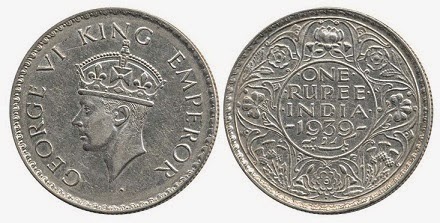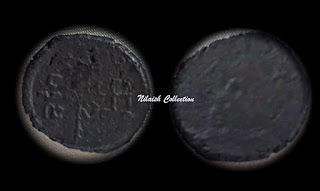The Kuninda kingdom's coin
The Kingdom of Kuninda (or Kulinda in ancient literature) was an ancient central Himalayan kingdom from around the 2nd century BCE to the 3rd century, located in the modern state of Uttarakhand and southern areas of Himachal in northern India.KingdomThe history of the kingdom is documented from around the 2nd century BCE. They are mentioned in Indian epics and Puranas. The Mahabharatarelates they were defeated by Arjuna.
One of the first kings of the Kuninda was Amoghbhuti, who ruled in the mountainous valley of the Yamuna andSutlej rivers (in today’s Uttarakhand and southern Himachal in northern India). The Greek historian Ptolemy linked the origin of the Kuninda to the country where the rivers Ganges, Yamuna, and Sutlej originate.
REFERENCE: Ptolemy, Geography 7.1.42: ὑπὸ δὲ τὰς Βιβάσιος καὶ τοῦ Ζαράδρου καὶ τοῦ Διαμούνα καὶ τοῦ Γάγγου ἡ Κυλινδρινή, “and enclosed by the Bibasis, the Zaradros, theDiamuna, and the Ganges is Kylindrinē.”
One of the Edicts of Ashoka on a pillar is also present at Kalsi, in the region of Garhwal, indicating the spread of Buddhism to the region from the 4th century BCE.The Koli Rajput’s of Garhwal and Kumaon traces ancestry from Kulindas.Kulin word came from Koli which means a person of high status and da denotes powerful man. The Kuninda kingdom disappeared around the 3rd century, and from the 4th century, it seems the region shifted to Shaivite beliefs.
The first coins of the Kuninda were influenced by the numismatic model of their predecessorIndo-Greek kingdoms, and incorporated Buddhist symbolism such as thetriratna. These coins typically follow the Indo-Greek weight and size standards ( drachms, of about 2.14g in weight and 19 mm in diameter), and their coins are often found together with Indo-Greek coins in hoards, such as those of the Yaudheyas, or the Audumbaras. They represent the first effort by a native Indian king to produce coins that could compare with those of the Indo-Greeks. The finds of Kuninda coins have often been associated with finds of Indo-Greek coins.
The first coins of the Kuninda were influenced by the numismatic model of their predecessorIndo-Greek kingdoms, and incorporated Buddhist symbolism such as thetriratna. These coins typically follow the Indo-Greek weight and size standards ( drachms, of about 2.14g in weight and 19 mm in diameter), and their coins are often found together with Indo-Greek coins in hoards, such as those of the Yaudheyas, or the Audumbaras. They represent the first effort by a native Indian king to produce coins that could compare with those of the Indo-Greeks. The finds of Kuninda coins have often been associated with finds of Indo-Greek coins.
A very large portion of the Kuninda coins are in the name of king Amoghabhuti, and it is believed that coinage under his name continued after his death. Some later coins bear the symbol of the Hindu god Shiva.
RulersAmoghabhuti (late 2nd century-1st century BCE).
RulersAmoghabhuti (late 2nd century-1st century BCE).



